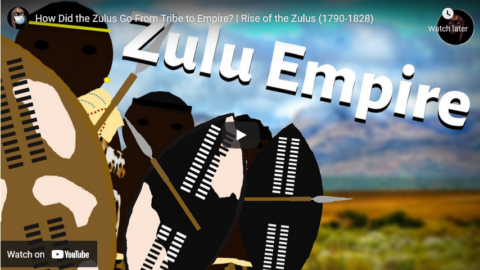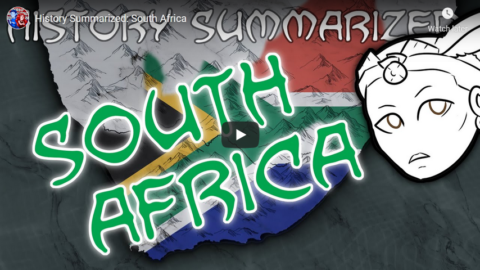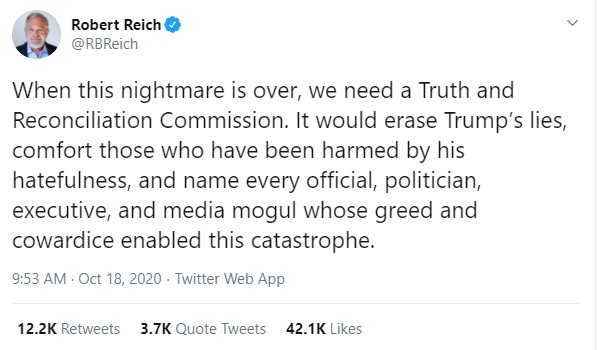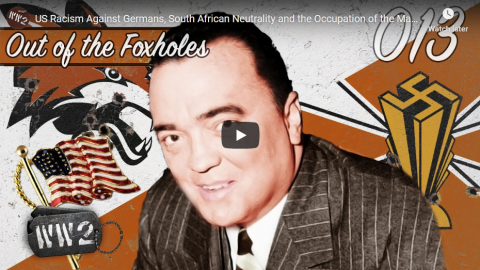Forgotten Weapons
Published 1 Jul 2018http://www.patreon.com/ForgottenWeapons
Cool Forgotten Weapons merch! http://shop.bbtv.com/collections/forg…
The iconic weapon of the Rhodesian Bush War is the FN-FAL, painted in a distinctive “baby poop” yellow and green pattern. Because Rhodesia was under international embargo, its options for obtaining weapons were limited. Some domestic production was undertaken, but one large source was neighboring South Africa. Both South African production FALs and also Belgian-made South African contract FALs were provided. This rifle is one of the latter, with the South African crest and proof marks defaced for some theoretical deniability should it be scrutinized.
Larry Vickers will talk us through this FAL, pointing out the different elements that are distinctly Rhodesian, as well as the unique Halbeck Device — and detachable muzzle brake.
Thanks to Larry for sharing this rifle with us!
If you enjoy Forgotten Weapons, check out its sister channel, InRangeTV! http://www.youtube.com/InRangeTVShow
Contact:
Forgotten Weapons
6281 N Oracle #36270
Tucson, AZ 85704
July 16, 2021
Rhodesian FAL – with Larry Vickers
June 10, 2021
The odd history of Irish Cream as we make Irish Cream hard candy at Lofty Pursuits
Lofty Pursuits
Published 25 Feb 2021Jake makes Irish Cream green shamrock hard candy for St. Patrick’s day. We discuss the history of the weird flavor and how it has become a tradition even though it was invented in the 1970’s
A great article about the history of Irish Cream
https://www.irishtimes.com/culture/bo…Buy our candy: http://www.pd.net
Listen to our podcast: http://loftypursuits.libsyn.com/website
Join our Patreon at https://www.patreon.com/LoftyPursuits
March 21, 2021
How Did the Zulus Go From Tribe to Empire? | Rise of the Zulus (1790-1828)
History With Hilbert
Published 28 Mar 2020Perhaps the most famous of Africa’s tribes, the Zulus rose to prominence under their King Shaka at the start of the 19th Century on the Eastern seaboard of what’s now South Africa. In the years following Shaka’s death his successors would have encounters with the Boer Voortrekkers and more famously, with the British culminating in the Anglo-Zulu War (1879) where they managed to decisively defeat them at the Battle of Isandlwana before themselves suffering defeat at the now infamous Battle of Rorke’s Drift. But in this video I’m not going to be talking about the much more well known story of the British Invasion of Zululand in the later 19th Century and the demise of the Zulu Empire, but rather about its origin and how it came about. In the 18th Century the Zulu as a people had only just become a separate entity, and certainly were not one of the major players on the scene before the time of Shaka. A series of factors played a role in their rise to power around the turn of the 19th Century, most notably the actions of Shaka himself as well as a shift in the way in which warfare was carried about by the tribes of the region and their interactions with European trading networks.
Go Fund My Windmills (Patreon):
https://www.patreon.com/HistorywithHi…Join in the Banter on Twitter:
https://twitter.com/HistorywHilbertIndulge in some Instagram..? (the alliteration needs to stop):
https://www.instagram.com/historywith…Music Used:
“Eine Kleine Nachtmusik” – Wolfgang Amadeus Mozart
“Expeditionary” – Kevin MacLeod
“Sunday Dub” – Kevin MacLeod (incompetech.com)
Licensed under Creative Commons: By Attribution 3.0 LicenseSend me an email if you’d be interested in doing a collaboration! historywithhilbert@gmail.com
#Zulu #SouthAfrica #History
February 20, 2021
History Summarized: South Africa
Overly Sarcastic Productions
Published 19 Feb 2021In the past few centuries, few corners of the African Continent were quite as busy as the south. It’s a winding river from the first migrations and waves of colonists in the Cape Colonies to the Rainbow Nation we know today, so let’s dive in and see how it all played out!
SOURCES & Further Reading for Black History Month:
— The African Experience From ‘Lucy’ to Mandela From the Great Courses Plus, lectures 15-18 “South Africa: The Dutch Cape Colony & The Zulu Kingdom & Frontier and Unification & Diamonds and Gold”, 26 “Segregation and Apartheid in South Africa”, and 32 “The South African Miracle”— Born A Crime by Trevor Noah: https://bookshop.org/books/born-a-cri…
— Home Team History is a YouTube channel covering all corners of the African continent. They have several videos about Southern Africa, such as “A History of Stone Architecture in Southern Africa” (https://youtu.be/0U4Wu3CmL0U) and “Southern Africa: The Birthplace of Iron Mining” (https://www.youtube.com/watch?v=b9HO0…), and “A history of the Xhosa People” (https://youtu.be/axajPiZnDqo)
— Lastly, looking to modern times, it’s important to recognize how the COVID crisis has exacerbated massive preexisting disparities between healthcare for Black and minority communities and that of white Americans. It’s not enough to just acknowledge history, we all have a responsibility to understand modern problems and work on solutions. Read more: (https://www.scientificamerican.com/ar…) and please consider Donating to support the NAACP’s COVID relief programs: (https://naacp.org/coronavirus/coronav…)With special thanks to the members of our discord community who helped polish my script: Holben, Klieg, Good Hunter, and Sticc (who has a History of Africa podcast: https://www.listennotes.com/podcasts/…)
This topic was voted on by our community of Patrons! If you’d like to get extra rewards and play a role in the content we make, please consider supporting our channel at https://www.Patreon.com/OSP
Our content is intended for teenage audiences and up.
PODCAST: https://overlysarcasticpodcast.transi…
DISCORD: https://discord.gg/osp
MERCH LINKS: http://rdbl.co/osp
OUR WEBSITE: https://www.OverlySarcasticProductions.com
Find us on Twitter https://www.Twitter.com/OSPYouTube
Find us on Reddit https://www.Reddit.com/r/OSP/
October 24, 2020
September 15, 2020
QotD: Racism and the minimum wage
During South Africa’s apartheid era, racist unions, which would never accept a black member, were the major supporters of minimum wages for blacks. In 1925, the South African Economic and Wage Commission said, “The method would be to fix a minimum rate for an occupation or craft so high that no Native would be likely to be employed.” Gert Beetge, secretary of the racist Building Workers’ Union, complained, “There is no job reservation left in the building industry, and in the circumstances, I support the rate for the job (minimum wage) as the second-best way of protecting our white artisans.” “Equal pay for equal work” became the rallying slogan of the South African white labor movement. These laborers knew that if employers were forced to pay black workers the same wages as white workers, there’d be reduced incentive to hire blacks.
South Africans were not alone in their minimum wage conspiracy against blacks. After a bitter 1909 strike by the Brotherhood of Locomotive Firemen and Enginemen in the U.S., an arbitration board decreed that blacks and whites were to be paid equal wages. Union members expressed their delight, saying, “If this course of action is followed by the company and the incentive for employing the Negro thus removed, the strike will not have been in vain.”
Our nation’s first minimum wage law, the Davis-Bacon Act of 1931, had racist motivation. During its legislative debate, its congressional supporters made such statements as, “That contractor has cheap colored labor that he transports, and he puts them in cabins, and it is labor of that sort that is in competition with white labor throughout the country.” During hearings, American Federation of Labor President William Green complained, “Colored labor is being sought to demoralize wage rates.”
Walter E. Williams, “Minimum Wage and Discrimination”, Creators Syndicate, 2017-02-08.
August 27, 2020
QotD: Racism and the minimum wage
Minimum-wage laws can even affect the level of racial discrimination. In an earlier era, when racial discrimination was both legally and socially accepted, minimum-wage laws were often used openly to price minorities out of the job market.
In 1925, a minimum-wage law was passed in the Canadian province of British Columbia, with the intent and effect of pricing Japanese immigrants out of jobs in the lumbering industry.
A Harvard professor of that era referred approvingly to Australia’s minimum wage law as a means to “protect the white Australian’s standard of living from the invidious competition of the colored races, particularly of the Chinese” who were willing to work for less.
In South Africa during the era of apartheid, white labor unions urged that a minimum-wage law be applied to all races, to keep black workers from taking jobs away from white unionized workers by working for less than the union pay scale.
Some supporters of the first federal minimum-wage law in the United States — the Davis-Bacon Act of 1931 — used exactly the same rationale, citing the fact that Southern construction companies, using non-union black workers, were able to come north and underbid construction companies using unionized white labor.
These supporters of minimum-wage laws understood long ago something that today’s supporters of such laws seem not to have bothered to think through. People whose wages are raised by law do not necessarily benefit, because they are often less likely to be hired at the imposed minimum-wage rate.
Thomas Sowell, “Why racists love the minimum wage laws”, New York Post, 2013-09-17.
June 10, 2020
US Racism Against Germans, South African Neutrality and the Occupation of the Maginot – OOTF 013
World War Two
Published 9 Jun 2020Did the neutral US discriminate against German- and Italian-Americans? And exactly how pro-Axis was South Africa? And what happened to the Maginot Line after the Fall of France? Find out as Indy answers three more of your interesting questions in this episode of Out of the Foxholes!
Join us on Patreon: https://www.patreon.com/TimeGhostHistory
Or join The TimeGhost Army directly at: https://timeghost.tvFollow WW2 day by day on Instagram @World_war_two_realtime https://www.instagram.com/world_war_t…
Between 2 Wars: https://www.youtube.com/playlist?list…
Source list: http://bit.ly/WW2sourcesHosted by: Indy Neidell
Written by: Rune Væver Hartvig
Director: Astrid Deinhard
Producers: Astrid Deinhard and Spartacus Olsson
Executive Producers: Astrid Deinhard, Indy Neidell, Spartacus Olsson, Bodo Rittenauer
Creative Producer: Joram Appel
Post-Production Director: Wieke Kapteijns
Research by: Rune Væver Hartvig
Edited by: Mikołaj Cackowski
Sound design: Marek Kamiński
Map animations: Eastory (https://www.youtube.com/c/eastory)Colorizations by:
Carlos Ortega Pereira, BlauColorizations – https://www.instagram.com/blaucolorizations
Norman Stewart – https://oldtimesincolor.blogspot.com/
Klimbim – https://www.flickr.com/photos/2215569…
Albert Einstein by Wayne DeganSources:
IWM Q 101768, TR 1262, Q 72178
Narodowe Archiwum Cyfrowe
Bundesarchiv
Les Bergers des Pierres – Moselle Association
from the Noun Project: id by Flatart, Fingerprint Recognition by Olena Panasovska, people by ProSymbolsSoundtracks from the Epidemic Sound:
Reynard Seidel – “Deflection”
Johannes Bornlof – “Deviation In Time”
Fabien Tell – “Last Point of Safe Return”
Philip Ayers – “Trapped in a Maze”
Johannes Bornlof – “The Inspector 4”Archive by Screenocean/Reuters https://www.screenocean.com.
A TimeGhost chronological documentary produced by OnLion Entertainment GmbH.
May 3, 2020
QotD: Tragic cultural misunderstandings
… the problem is how cultures “read” things and people can be completely different/opposite. Part of our issue with Islamic culture is just that: cultural. They’d never get in the pissing contest they are pushing, if they could read us accurately. And arguably our liberals would never be pushing for peace and appeasement if they could read THEM accurately.
It’s one of those cultural traps which I have read about and which are tragic.
I think I’ve spoken before of the tragic encounter between Zulu and Boers in South Africa. Zulus were doing what they did that had won them Africa (they came from central Africa shortly before the whites arrived): Commit incredibly scary atrocities so the enemy runs/avoids combat/submits. The whites were in their head just another tribe. They could not understand the idea of a “tribe” that was starting to span the globe and which would self-identify as “tribe” in the face of a savage. So their savagery made the Europeans MORE determined to wipe them out.
We’re seeing something like that, again. Islamic CULTURES are big on bragging, exaggeration of force and intimidation of the enemy. This is functional in a desert where there’s always a lot of low-level “war.” Some atrocities, scare “the enemy” and you keep your patch, and you go on. They have a fine tuned ear for this. When the other tribe isn’t committing atrocities against YOU and particularly when they’re being appeasing/accommodating, you have them over a barrel. If you strike with showy force you can take their stuff and enslave them. NOTE most of the attacks are designed to be showy.
TWO things they don’t get: Our elites are appeasing because the elites think they’re SO powerful they can’t be touched and are oikophobes who hate their own people. AND our PEOPLE is pissed, really pissed.
You know the old joke? There are no Muslims in Star Trek because it’s set in the future.
This is unfortunately the likely outcome of the cultures meeting. At some point (already happening) the elites will have to fight or be replaced. And when we go to war, our power is incalculable compared to them. They think we exaggerate our strength, while, culturally, we underplay it. They don’t understand we’re holding back.
The result will be a horrific destruction of guilty and innocent alike and even people like me who look Arab/Mediterranean in a bad light will be at risk.
And they will be the victims of genocide.
Sarah Hoyt, “Cross-Culture”, According to Hoyt, 2017-03-23.
April 5, 2020
Book Review: The Martini Henry, For Queen and Empire
Forgotten Weapons
Published 8 Dec 2019Get your copy direct from IMA: https://www.ima-usa.com/products/the-…
Or from Amazon here: https://amzn.to/2O7ZGOY
Don’t miss Alpinshaw’s own website: http://www.martinihenry.org
One of the perennial challenges facing authors of firearms reference books is balancing the very technical nit-pickery with the broad historical view of a gun and its context in world events. The emphasis is usually tending towards the technical, but Neil Alpinshaw has done an excellent job of balancing the two, and made the development of the Martini-Henry an engaging story at the same time (a rare feat in this genre!). His new book The Martini-Henry: For Queen and Empire mixes vivid descriptions of British troops fighting across the far-flung corners of the world with their trusted Martinis with a history of the development and modernization of the rifles (and carbines).
Most interesting to me personally was the section on the Martini-Enfield, which was to be the improved version of the Martini-Henry. Chambered for a smaller-bore .402 caliber cartridge and fitted with sights for rapid close-in combat as well as long-range volley fire and sporting a quick-loading magazine attached to the receiver, this is a fascinating look at the highest evolution of the single-shot black-powder military rifle. Its development was dashed by the bolt action Lee and the development of smokeless powder, and the many thousands initially produced were converted into other patterns before seeing service.
Aspinshaw also tackles many of the long-standing myths about the Martini, and particularly its weaknesses. He takes his information directly from period investigations and after-action reports, and avoids the common hearsay. He does not let his own personal passion for the subject prevent him from articulating the true problems the rifles had, but clears away the misconceptions that have become prevalent (like the impossible-to-open ammunition boxes).
Published by International Military Antiques, the cover price is $60, and it is worth every penny for anyone interested in the grand Victorian British Empire or the Martini as a firearms family.
http://www.patreon.com/ForgottenWeapons
Cool Forgotten Weapons merch! http://shop.bbtv.com/collections/forg…
Contact:
Forgotten Weapons
6281 N. Oracle #36270
Tucson, AZ 85704
March 14, 2020
QotD: Apartheid
To anyone who was exposed to its machinations — let alone directly affected by it, as most South African Blacks were — apartheid was truly evil: only the absence of extermination camps differentiated it from the Nazism of the 1940s. In actuality, Blacks couldn’t live or work in “White” areas except by permit, couldn’t own businesses in White areas, couldn’t be promoted past a certain point when they did work outside the “Black” areas, and were forcibly resettled into Black “homelands” without legal redress or the ability to resist. Social intercourse between Blacks and Whites were restricted, by law, to business interactions only — any kind of interracial sexual activity was legally classified as “immorality” and summarily banned, carrying appallingly-high penalties in the breach thereof. Crimes by Whites against Blacks carried penalties far more lenient — to the extent of semi-official toleration — than those by Blacks against Whites, which were severely punished. The education system favored White children over Black children and continued throughout life — to where “White” universities were ubiquitous but “Black” universities could be counted on one hand, with a couple fingers left over. (Lest anyone is offended by the comparison to Nazism, simply substitute “Jews” for “Blacks” and “Aryans” for “Whites”. That would have been Germany, from 1933 to 1945.)
So the disappearance of apartheid cannot be seen as anything other than a Good Thing.
Kim du Toit, “Tough Question, Simple Answer”, Splendid Isolation, 2019-12-05.
March 7, 2020
The death of Prince Imperial, The Last Napoleon
The History Guy: History Deserves to Be Remembered
Published 14 Jul 2017The History Guy remembers when the hopes to restore the Second French Empire die in South Africa with Prince Imperial, the last Napoleon. It is history that deserves to be remembered.
The History Guy uses images that are in the Public Domain. As photographs of actual events are often not available, I will sometimes use photographs of similar events or objects for illustration.
Patreon: https://www.patreon.com/TheHistoryGuy
The History Guy: Five Minutes of History is the place to find short snippets of forgotten history from five to fifteen minutes long. If you like history too, this is the channel for you.
The episode is intended for educational purposes. All events are presented in historical context.
#worldhistory #thehistoryguy #militaryhistory
February 16, 2020
Diamonds vs. Self Determination – South West Africa and the League of Nations I THE GREAT WAR 1920
The Great War
Published 15 Feb 2020Sign up for Curiosity Stream and Nebula: https://curiositystream.com/thegreatwar
Woodrow Wilson’s 14 Points and their idea of self-determination didn’t go unnoticed in the former German colonies like German Southwest Africa. But especially South Africa had other ideas at the Paris Peace Conference and lobbied to take control over future Namibia and its lucrative diamond mines.
» SUPPORT THE CHANNEL
Patreon: https://www.patreon.com/thegreatwar
Merchandise: https://shop.spreadshirt.de/thegreatwar/» SOURCES
Emmett, Tony. 1999. Popular Resistance and the Roots of Nationalism in Namibia, 1915-1966. Basel, Switzerland: P. Schlettwein Publishing.
Olusoga, David, and Casper W. Erichsen. 2011. The Kaiser’s Holocaust: Germany’s Forgotten Genocide and the Colonial Roots of Nazism. London, UK: Faber and Faber.
Onselen, Charles van. 1980. Chibaro: African mine labour in Southern Rhodesia 1900-1933. London, UK: Pluto Pr.
Pirio, Gregory. 1988. “The Role of Garveyism in the Making of Namibian Nationalism.” In Namibia 1884-1984: Readings on Namibia’s History and Society: Selected Papers and Proceedings of the International Conference on “Namibia 1884-1984: 100 Years of Foreign Occupation; 100 Years of Struggle”, London 10-13 September, 1984, Organised by the Namibia Support Committee in Co-Operation with the SWAPO Department of Information and Publicity, edited by International Conference on “Namibia 1884-1984: 100 Years of Foreign Occupation; 100 Years of Struggle,” Brian Wood, Namibia Support Committee, United Nations Institute for Namibia, SWAPO, and Department of Information and Publicity. London: The Committee in cooperation with United Nations Institute for Namibia.
“Report on the Natives of South-West Africa and Their Treatment by Germany.” 1918. 1918. https://ufdc.ufl.edu/UF00072665/00001/1j.
Silvester, Jeremy, and Jan-Bart Gewald, eds. 2003. Words Cannot Be Found: German Colonial Rule in Namibia: An Annotated Reprint of the 1918 Blue Book. Sources for African History, v. 1. Leiden, NL ; Boston, USA: Brill.
Smith, Iain R. 1999. “Jan Smuts and the South African War.” South African Historical Journal 41 (1): 172–95. https://doi.org/10.1080/0258247990867….
Vinson, Robert Trent. 2012. Americans Are Coming! Dreams of African American Liberation in Segregationist South Africa. Athens: Ohio University Press. http://public.eblib.com/choice/public….
Wallace, Marion, and John Kinahan. 2013. A History of Namibia from the Beginning to 1990. Oxford, UK: Oxford University Press.
William Blakemore Lyon. 2015. “The South West Africa Company and Anglo-German Relations, 1892-1914.” Master’s thesis, Cambridge University.
Zimmerer, Jürgen, and Joachim Zeller. 2008. Genocide in German South-West Africa. Monmouth, UK: Merlin Press.
Michell, Lewis (1910). The Life and Times of the Right Honourable Cecil John Rhodes 1853-1902, Volume 2. New York and London: Mitchell Kennerly
Rhodes, Cecil, (1902) “The Last Will and Testament of Cecil John Rhodes: With Elucidatory Notes to Which Are Added Some Chapters Describing the Political and Religious Ideas of the Testator”, London: “Review of Reviews” Office
Cecil Rhodes, “Confession of Faith”, 1877 https://pages.uoregon.edu/kimball/Rho…» SOCIAL MEDIA
Instagram: https://instagram.com/the_great_war
Twitter: https://twitter.com/WW1_Series
Reddit: https://reddit.com/r/TheGreatWarChannel»CREDITS
Presented by: Jesse Alexander
Written by: Jesse Alexander
Director: Toni Steller & Florian Wittig
Director of Photography: Toni Steller
Sound: Toni Steller
Editing: Toni Steller
Mixing, Mastering & Sound Design: http://above-zero.com
Maps: Daniel Kogosov (https://www.patreon.com/Zalezsky)
Research by: Jesse Alexander
Fact checking: Florian WittigChannel Design: Alexander Clark
Original Logo: David van StepholdA Mediakraft Networks Original Channel
Contains licensed material by getty images
All rights reserved – Real Time History GmbH 2020
November 7, 2019
Boer Lee-Speed Rifle from the Jameson Raid
Forgotten Weapons
Published on 29 Aug 2019The Jameson Raid in December 1895 was one of the key events in the lead to the second Boer War. Leander Jameson took a force of about 600 men on December 1895 to make a surprise attach on Johannesburg, incite support for the multitude of British miners who felt oppressed by the Boer government, and ultimately bring in British forces to take over. The plan failed in a complete and public manner, though, as Boer forces knew about it from the very beginning. The raiding party was ambushed at Doornkop outside Johannesburg and forced to surrender. It was a tremendous public relations setback for supporters of British intervention.
In addition, the Boers captured a nice selection of very modern arms, including half a dozen artillery pieces, a dozen Maxim machine guns, and about 500 Lee rifles. This Lee-Speed is one of them, given to a Boer burgher who used it in the war that eventually broke out in 1899. He carved his name into the stock, as was common for the Boers. This is one of only two known and documented surviving rifles from the Jameson Raid, and it is both a very cool piece of history for that reason as well as a great time capsule of the Lee-Metford MkI pattern of rifle. Most of the early Lees in British military service were updated and repurposed over the decades, and finding them in original configuration is quite difficult today.
http://www.patreon.com/ForgottenWeapons
Cool Forgotten Weapons merch! http://shop.bbtv.com/collections/forg…
Contact:
Forgotten Weapons
PO Box 87647
Tucson, AZ 85754
October 25, 2019
“Rorke’s Drift” – The Anglo-Zulu War – Sabaton History 038 [Official]
Sabaton History
Published 24 Oct 2019The Battle of Rorke’s Drift was the last stand for the British defenders, facing thousands of Zulu fighters with only a few hundred of their own.
Support Sabaton History on Patreon: https://www.patreon.com/sabatonhistory
Listen to The Last Stand where “Rorke’s Drift” is featured):
CD: http://bit.ly/TheLastStandStore
Spotify: http://bit.ly/TheLastStandSpotify
Apple Music: http://bit.ly/TheLastStandItunes
iTunes: http://bit.ly/TheLastStandItunes
Amazon: http://bit.ly/TheLastStandAmz
Google Play: http://bit.ly/TheLastStandGooglePlayWatch the official lyric video of “Rorke’s Drift” here: https://www.youtube.com/watch?v=i9Bup…
Hosted by: Indy Neidell
Written by: Markus Linke and Indy Neidell
Directed by: Astrid Deinhard and Wieke Kapteijns
Produced by: Pär Sundström, Astrid Deinhard and Spartacus Olsson
Creative Producer: Joram Appel
Executive Producers: Pär Sundström, Joakim Broden, Tomas Sunmo, Indy Neidell, Astrid Deinhard, and Spartacus Olsson
Post-Production Director: Wieke Kapteijns
Maps by: Eastory
Edited by: Iryna Dulka
Sound Editing by: Marek KaminskiEastory YouTube Channel: https://www.youtube.com/channel/UCEly…
Archive by: Reuters/Screenocean https://www.screenocean.com
Music by Sabaton.Sources:
– The National Archives UK
– A group of Zulu men in war dress, a photograph by Robert Harris. Credit: Wellcome Collection.
– Episodes in the Zulu wars, Credit: Wellcome Collection
– Field ambience by dobroide from freesound.orgAn OnLion Entertainment GmbH and Raging Beaver Publishing AB co-Production.
© Raging Beaver Publishing AB, 2019 – all rights reserved.
From the comments:
Sabaton History
2 days ago (edited)
One nation’s heroic history is another’s national tragedy. In academia, the horrors of imperialism get more and more attention each year. In this episode, besides covering the events that unfolded during the Battle of Rorke’s Drift, we try to capture the ambiguous nature of colonial history. Yes, the last stand of the British soldiers against an overwhelming Zulu force is impressive, but whether or not it should be celebrated is open for debate. We would like to have this conversation in the comments down below, but keep it civil. Any racist, apologist or revisionist comments can lead to a ban.
Cheers, The Sabaton History Team.














